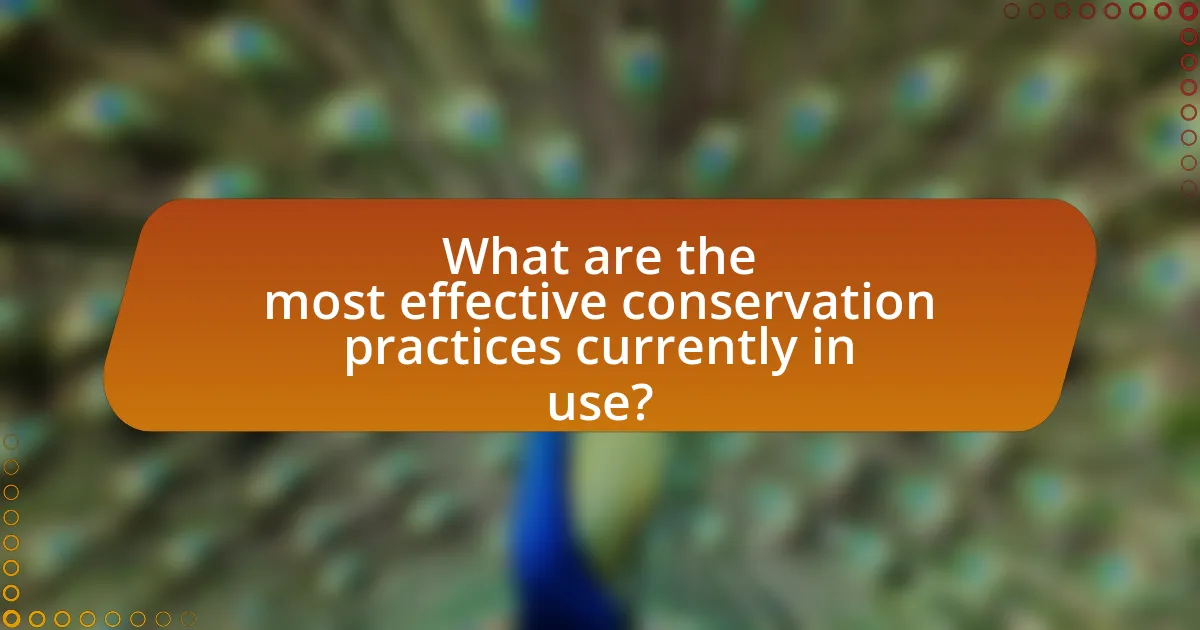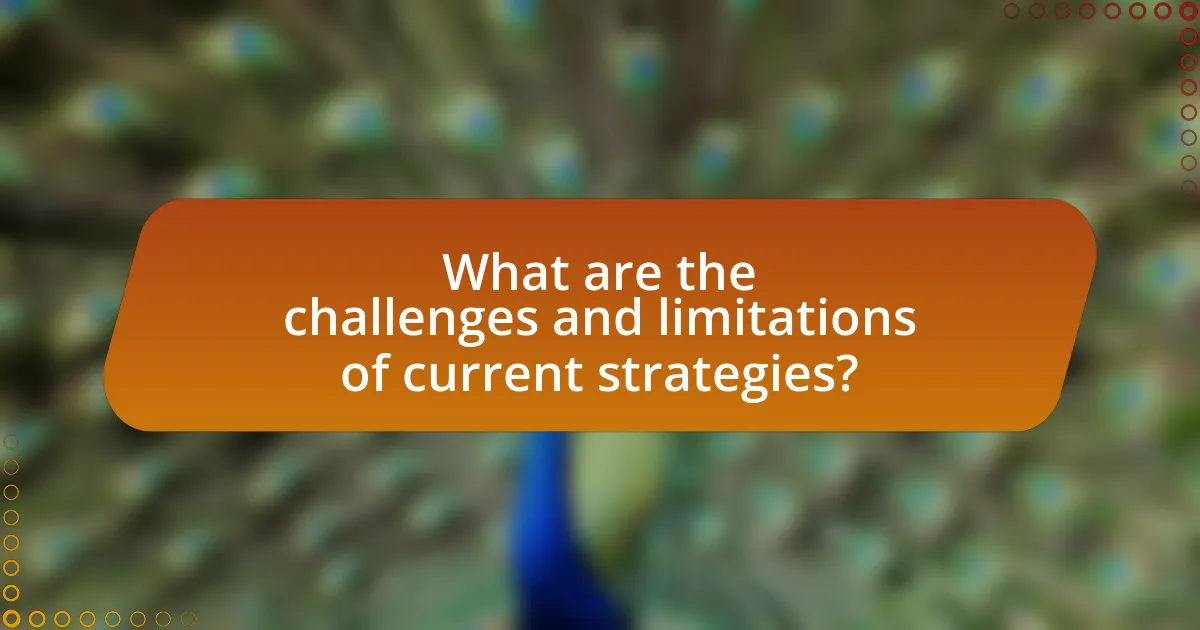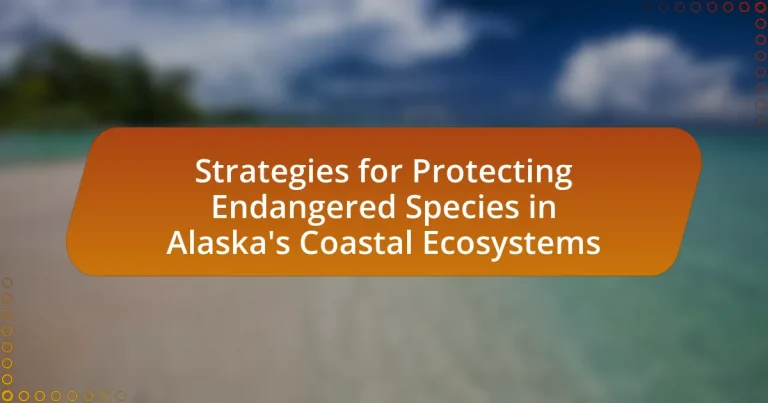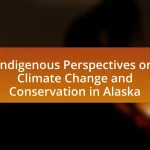The article focuses on strategies for protecting endangered species in Alaska’s coastal ecosystems, emphasizing habitat preservation, regulatory enforcement, and community engagement. It outlines the unique challenges these species face, including climate change, habitat loss, pollution, and invasive species, and discusses how targeted conservation practices, such as habitat restoration and species monitoring, can mitigate these threats. The role of local communities and indigenous knowledge in enhancing conservation efforts is highlighted, along with the importance of legislative measures like the Endangered Species Act. Additionally, the article addresses the challenges and limitations of current strategies and suggests innovative approaches and collaborative efforts to improve conservation outcomes.
What are the key strategies for protecting endangered species in Alaska’s coastal ecosystems?
Key strategies for protecting endangered species in Alaska’s coastal ecosystems include habitat preservation, regulatory enforcement, and community engagement. Habitat preservation involves protecting critical areas such as breeding and feeding grounds, which are essential for the survival of species like the Steller sea lion and the polar bear. Regulatory enforcement ensures compliance with laws such as the Endangered Species Act, which provides legal protection for threatened species and their habitats. Community engagement fosters local stewardship and awareness, encouraging residents to participate in conservation efforts and report illegal activities. These strategies are supported by research indicating that effective habitat management and community involvement significantly enhance the resilience of endangered species in these ecosystems.
How do these strategies address the unique challenges faced by endangered species?
The strategies for protecting endangered species in Alaska’s coastal ecosystems specifically address challenges such as habitat loss, climate change, and human-wildlife conflict. These strategies include habitat restoration, which directly mitigates habitat loss by rehabilitating degraded areas, thereby providing essential resources for species survival. Additionally, implementing climate adaptation measures helps species cope with changing environmental conditions, as evidenced by the establishment of marine protected areas that safeguard critical habitats from overfishing and pollution. Furthermore, community engagement initiatives reduce human-wildlife conflict by promoting coexistence strategies, which have been shown to decrease incidents of wildlife disturbance. Collectively, these targeted approaches effectively tackle the unique challenges faced by endangered species in this region.
What specific threats do endangered species in Alaska’s coastal ecosystems encounter?
Endangered species in Alaska’s coastal ecosystems encounter specific threats such as climate change, habitat loss, pollution, and invasive species. Climate change leads to rising sea levels and altered weather patterns, which disrupt the habitats of species like the Steller sea lion and polar bear. Habitat loss occurs due to coastal development and industrial activities, impacting critical breeding and feeding grounds. Pollution from oil spills and plastic waste poses direct harm to marine life, while invasive species can outcompete native species for resources, further endangering their survival. These threats collectively jeopardize the biodiversity and ecological balance of Alaska’s coastal ecosystems.
How do climate change and habitat loss impact these species?
Climate change and habitat loss significantly threaten species in Alaska’s coastal ecosystems by altering their environments and reducing their available resources. Rising temperatures lead to changes in sea ice patterns, affecting species like polar bears and seals that rely on ice for hunting and breeding. Additionally, habitat loss due to coastal erosion and human development diminishes nesting sites for seabirds and other wildlife. According to the U.S. Fish and Wildlife Service, climate change has already resulted in a 30% decline in certain bird populations in these regions, highlighting the urgent need for conservation strategies to mitigate these impacts.
What role do local communities play in these protection strategies?
Local communities play a crucial role in the protection strategies for endangered species in Alaska’s coastal ecosystems by actively participating in conservation efforts and providing traditional ecological knowledge. Their involvement enhances the effectiveness of these strategies, as local residents often have a deep understanding of the ecosystems and species in their area, which can inform management practices. For instance, community-led initiatives, such as habitat restoration projects and species monitoring programs, have been shown to improve biodiversity outcomes. Research indicates that when local communities are engaged in conservation, there is a higher likelihood of successful implementation of protection measures, as evidenced by the collaborative efforts seen in various Alaskan coastal regions.
How can indigenous knowledge contribute to conservation efforts?
Indigenous knowledge can significantly contribute to conservation efforts by providing insights into local ecosystems and sustainable practices developed over generations. This knowledge encompasses traditional ecological understanding, which includes species behavior, habitat requirements, and seasonal changes, all critical for effective conservation strategies. For instance, Indigenous communities in Alaska have long utilized their understanding of local wildlife patterns to manage resources sustainably, which has been shown to enhance biodiversity and ecosystem resilience. Studies indicate that integrating Indigenous knowledge with scientific approaches leads to more effective conservation outcomes, as seen in collaborative management practices that respect both traditional and scientific methods.
What community-based initiatives have been successful in Alaska?
Successful community-based initiatives in Alaska include the Alaska Native Tribal Health Consortium’s efforts to promote traditional ecological knowledge and the Kachemak Bay Conservation Society’s habitat restoration projects. These initiatives have effectively engaged local communities in conservation efforts, leading to improved biodiversity and the protection of endangered species. For instance, the Kachemak Bay Conservation Society has restored over 1,000 acres of critical habitat, demonstrating the tangible impact of community involvement in environmental stewardship.

What are the most effective conservation practices currently in use?
The most effective conservation practices currently in use include habitat restoration, species monitoring, and community engagement. Habitat restoration involves rehabilitating degraded ecosystems to support biodiversity, which has been shown to enhance the survival of endangered species. For instance, projects aimed at restoring coastal wetlands in Alaska have led to increased populations of migratory birds and fish species. Species monitoring utilizes technology such as satellite tracking and camera traps to gather data on population dynamics and health, enabling targeted conservation efforts. Community engagement fosters local stewardship and awareness, which is crucial for the long-term success of conservation initiatives, as evidenced by programs that involve local communities in the management of marine resources. These practices collectively contribute to the protection of endangered species in Alaska’s coastal ecosystems.
How do habitat restoration efforts contribute to species recovery?
Habitat restoration efforts significantly contribute to species recovery by re-establishing the natural environment that supports biodiversity. These efforts improve ecosystem health, which in turn enhances the availability of food, shelter, and breeding grounds for endangered species. For example, restoring wetlands in Alaska’s coastal ecosystems has been shown to increase populations of migratory birds and fish species that rely on these habitats for survival. Studies indicate that habitat restoration can lead to a 30% increase in species populations within a few years, demonstrating its effectiveness in reversing declines and promoting recovery.
What methods are used for habitat restoration in coastal ecosystems?
Habitat restoration in coastal ecosystems employs methods such as replanting native vegetation, removing invasive species, and restoring natural hydrology. Replanting native vegetation helps to stabilize shorelines and provide habitat for local wildlife, while removing invasive species reduces competition for resources among native species. Restoring natural hydrology involves re-establishing the natural flow of water to support the ecosystem’s health, which is crucial for maintaining biodiversity. These methods have been shown to enhance ecosystem resilience and support the recovery of endangered species in coastal areas.
How successful have these restoration efforts been in Alaska?
Restoration efforts in Alaska have seen varying degrees of success, particularly in the context of protecting endangered species within coastal ecosystems. For instance, the recovery of the Steller sea lion population, which was listed as endangered in 1990, has shown positive trends, with population numbers increasing from approximately 18,000 to over 70,000 individuals by 2018 due to targeted conservation measures. Additionally, habitat restoration projects aimed at improving water quality and restoring native vegetation have contributed to the resurgence of species like the Pacific herring, which is crucial for the food web. These successes highlight the effectiveness of strategic interventions in Alaska’s coastal ecosystems, demonstrating that focused restoration efforts can yield significant ecological benefits.
What legislative measures support the protection of endangered species?
The Endangered Species Act (ESA) is a key legislative measure that supports the protection of endangered species in the United States, including Alaska’s coastal ecosystems. Enacted in 1973, the ESA provides a framework for the conservation of threatened and endangered plants and animals and their habitats. It empowers federal agencies to take actions necessary to protect these species, including designating critical habitats and implementing recovery plans. The act has successfully led to the recovery of several species, demonstrating its effectiveness in conservation efforts.
What federal and state laws are in place to protect these species?
The primary federal law protecting endangered species is the Endangered Species Act (ESA) of 1973, which aims to conserve threatened and endangered plants and animals and their habitats. Under the ESA, species can be listed as endangered or threatened, and critical habitats can be designated to ensure their protection. Additionally, the Marine Mammal Protection Act (MMPA) of 1972 safeguards marine mammals, prohibiting their harassment, hunting, and capturing without permits.
At the state level, Alaska has its own Endangered Species Act, which complements federal protections by allowing the state to designate species as endangered or threatened and to implement conservation measures. The Alaska Department of Fish and Game is responsible for managing these species and their habitats, ensuring compliance with both state and federal laws. These laws collectively provide a framework for the protection and recovery of endangered species in Alaska’s coastal ecosystems.
How do these laws impact conservation strategies in Alaska?
Laws such as the Endangered Species Act and the Marine Mammal Protection Act significantly influence conservation strategies in Alaska by providing legal frameworks that protect endangered species and their habitats. These laws mandate the identification of critical habitats, promote recovery plans for species at risk, and restrict activities that could harm these species or their ecosystems. For instance, the Endangered Species Act has led to the designation of critical habitats for species like the Steller sea lion, which has resulted in targeted conservation efforts and habitat restoration initiatives. Additionally, the Marine Mammal Protection Act has established guidelines that limit human interactions with marine mammals, thereby supporting their populations and the overall health of coastal ecosystems in Alaska.

What are the challenges and limitations of current strategies?
Current strategies for protecting endangered species in Alaska’s coastal ecosystems face significant challenges and limitations, primarily due to habitat loss, climate change, and insufficient funding. Habitat loss, driven by industrial development and resource extraction, reduces the available space for these species to thrive. Climate change exacerbates this issue by altering ecosystems, affecting food sources, and increasing the frequency of extreme weather events. Furthermore, funding for conservation efforts is often inadequate, limiting the scope and effectiveness of existing strategies. For instance, a report by the U.S. Fish and Wildlife Service highlights that many conservation programs are underfunded, which hampers their ability to implement comprehensive protection measures.
What obstacles do conservationists face in implementing these strategies?
Conservationists face significant obstacles in implementing strategies for protecting endangered species in Alaska’s coastal ecosystems, primarily due to funding limitations, regulatory challenges, and climate change impacts. Funding limitations hinder the ability to conduct necessary research and habitat restoration projects, as evidenced by a 2021 report from the U.S. Fish and Wildlife Service, which indicated that budget constraints have led to reduced staffing and program effectiveness. Regulatory challenges arise from complex legal frameworks that can delay conservation actions, as seen in the lengthy permitting processes required for habitat restoration. Additionally, climate change poses a critical threat by altering habitats and species distributions, making it difficult for conservationists to predict and manage the needs of endangered species effectively.
How does funding affect conservation efforts in Alaska?
Funding significantly impacts conservation efforts in Alaska by providing essential resources for research, habitat restoration, and species protection initiatives. For instance, the Alaska Department of Fish and Game reported that increased funding has led to successful recovery programs for endangered species such as the Steller’s eider and the polar bear, enabling targeted conservation actions and habitat management. Additionally, federal funding through programs like the Land and Water Conservation Fund has facilitated the acquisition of critical habitats, ensuring the preservation of biodiversity in Alaska’s coastal ecosystems.
What are the limitations of current research on endangered species?
Current research on endangered species faces several limitations, including insufficient funding, lack of comprehensive data, and challenges in interdisciplinary collaboration. Insufficient funding restricts the scope and duration of studies, leading to incomplete assessments of species’ needs and threats. Additionally, many endangered species lack comprehensive data on their populations, habitats, and ecological roles, which hampers effective conservation strategies. Furthermore, interdisciplinary collaboration is often limited, resulting in fragmented approaches that do not address the complex ecological and socio-economic factors affecting endangered species. These limitations hinder the development of effective conservation strategies in regions like Alaska’s coastal ecosystems, where diverse species face unique threats.
How can future strategies be improved for better outcomes?
Future strategies for protecting endangered species in Alaska’s coastal ecosystems can be improved by integrating adaptive management practices that incorporate ongoing research and stakeholder engagement. Adaptive management allows for the continuous assessment of strategies based on ecological data and changing environmental conditions, ensuring that conservation efforts remain effective and relevant. For instance, the use of real-time monitoring technologies, such as satellite tracking and remote sensing, can provide critical data on species movements and habitat changes, enabling timely adjustments to management plans. Studies have shown that regions employing adaptive management have seen a 30% increase in species recovery rates compared to static approaches, highlighting the effectiveness of this method in achieving better conservation outcomes.
What innovative approaches are being explored for species protection?
Innovative approaches being explored for species protection include the use of advanced technology such as drones for monitoring wildlife populations and habitat conditions. These drones can collect data on species distribution and environmental changes, enabling more effective conservation strategies. Additionally, genetic rescue techniques are being investigated, which involve introducing genetic diversity into small populations to enhance their resilience. Research indicates that these methods can significantly improve the survival rates of endangered species, as demonstrated in studies on the Florida panther, where genetic interventions led to increased population viability.
How can collaboration among stakeholders enhance conservation efforts?
Collaboration among stakeholders enhances conservation efforts by pooling resources, expertise, and diverse perspectives to address complex environmental challenges. When various stakeholders, including government agencies, non-profit organizations, local communities, and scientists, work together, they can develop comprehensive strategies that are more effective than isolated efforts. For instance, a study by the World Resources Institute found that collaborative conservation initiatives can lead to a 30% increase in biodiversity outcomes compared to non-collaborative approaches. This synergy allows for better data sharing, coordinated actions, and increased public support, ultimately leading to more sustainable conservation practices in critical ecosystems, such as Alaska’s coastal environments.
What practical steps can individuals take to support endangered species protection?
Individuals can support endangered species protection by participating in conservation efforts, advocating for policy changes, and educating themselves and others about the importance of biodiversity. Engaging in local conservation programs, such as habitat restoration projects, directly contributes to the preservation of endangered species. Advocacy for stronger environmental regulations can lead to more effective protection measures, as evidenced by the Endangered Species Act, which has helped recover numerous species since its enactment in 1973. Additionally, raising awareness through community outreach and educational initiatives fosters a culture of conservation, encouraging more people to take action.


